Creating Shared Value by Business: An In-Depth Analysis
VerifiedAdded on 2021/09/19
|6
|1653
|440
Essay
AI Summary
This essay analyzes the article "Creating Shared Value" by Michael E. Porter and Mark R. Kramer, published in the Harvard Business Review. It discusses how businesses can achieve economic success by addressing societal needs and creating shared value. The essay explores the connection between societal and economic progress, emphasizing how companies can reconceive products and markets to benefit both themselves and the community. It highlights the importance of shared value in gaining a competitive advantage, improving profitability, and strengthening a company's position. The essay also contrasts corporate social responsibility with shared value creation, pointing out that the latter can open ways to increase the efficiency of a firm. It provides examples of companies that have successfully integrated social concerns into their business models, such as Thomson Reuters and Wal-Mart, and discusses the role of non-profit companies in addressing global issues. The essay further explores how self-regulated businesses can improve their standing and reduce scrutiny from regulators. It also mentions the strengths and weaknesses of the article, emphasizing the importance of a firm's contribution to the broader society.
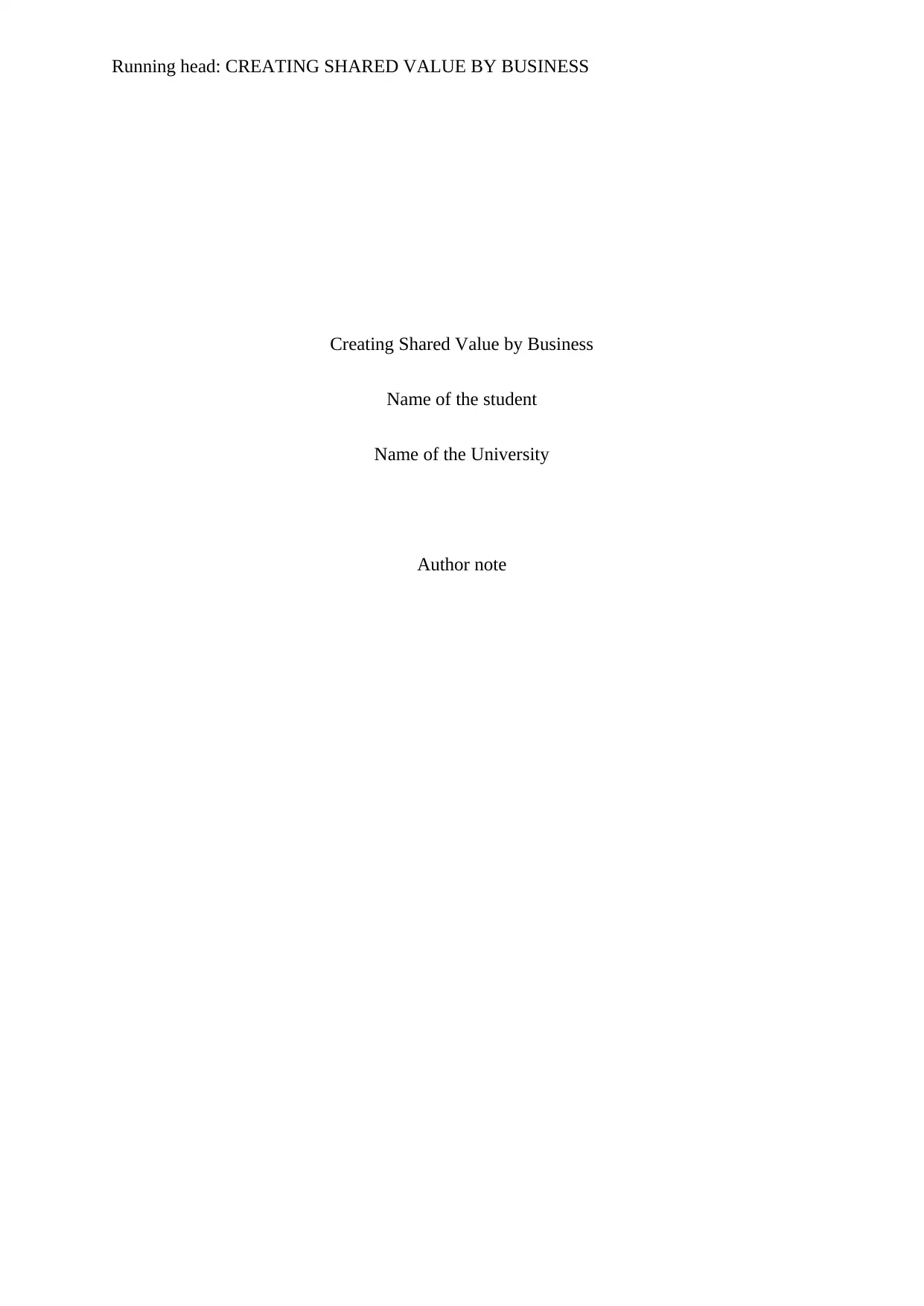
Running head: CREATING SHARED VALUE BY BUSINESS
Creating Shared Value by Business
Name of the student
Name of the University
Author note
Creating Shared Value by Business
Name of the student
Name of the University
Author note
Paraphrase This Document
Need a fresh take? Get an instant paraphrase of this document with our AI Paraphraser
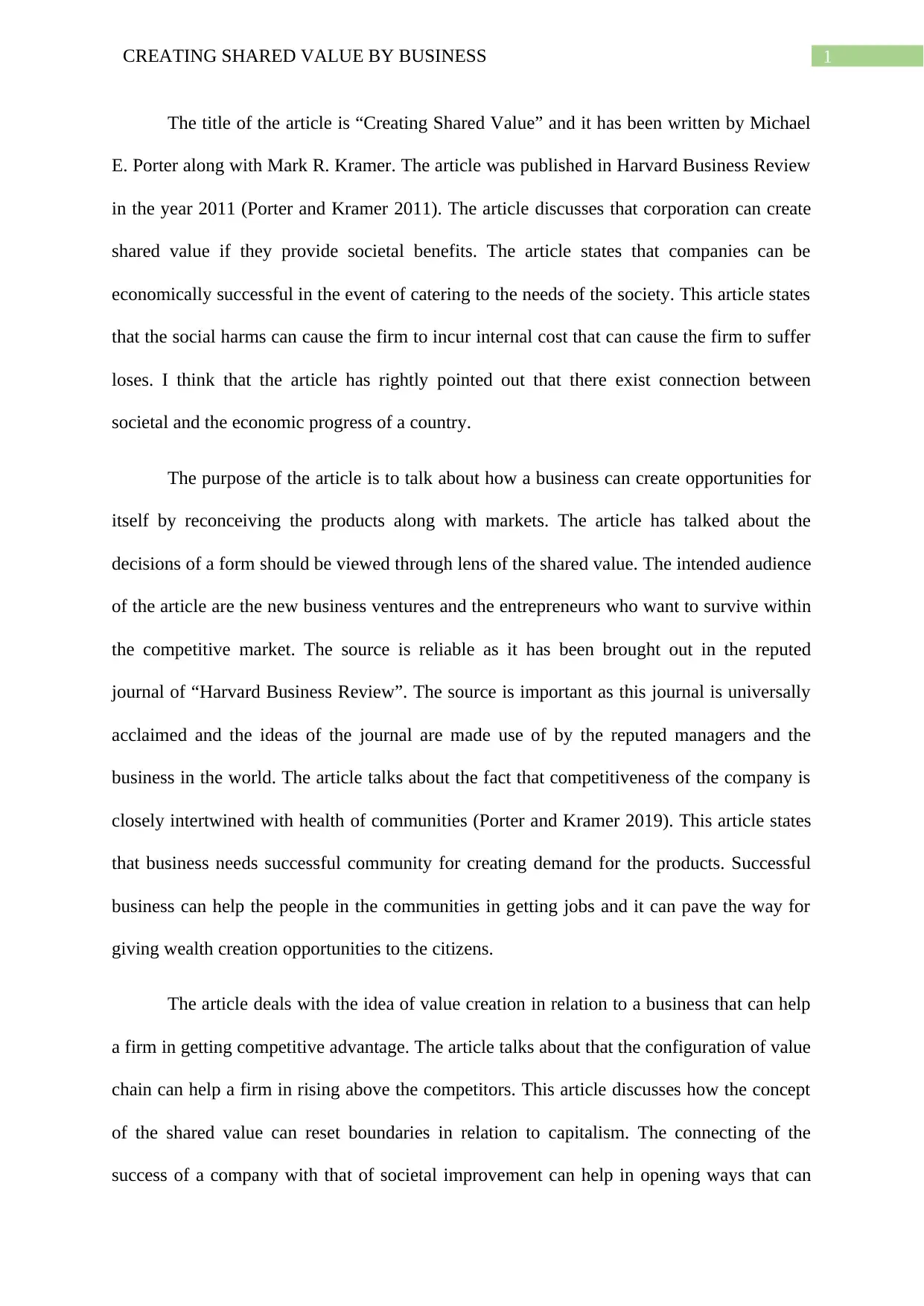
1CREATING SHARED VALUE BY BUSINESS
The title of the article is “Creating Shared Value” and it has been written by Michael
E. Porter along with Mark R. Kramer. The article was published in Harvard Business Review
in the year 2011 (Porter and Kramer 2011). The article discusses that corporation can create
shared value if they provide societal benefits. The article states that companies can be
economically successful in the event of catering to the needs of the society. This article states
that the social harms can cause the firm to incur internal cost that can cause the firm to suffer
loses. I think that the article has rightly pointed out that there exist connection between
societal and the economic progress of a country.
The purpose of the article is to talk about how a business can create opportunities for
itself by reconceiving the products along with markets. The article has talked about the
decisions of a form should be viewed through lens of the shared value. The intended audience
of the article are the new business ventures and the entrepreneurs who want to survive within
the competitive market. The source is reliable as it has been brought out in the reputed
journal of “Harvard Business Review”. The source is important as this journal is universally
acclaimed and the ideas of the journal are made use of by the reputed managers and the
business in the world. The article talks about the fact that competitiveness of the company is
closely intertwined with health of communities (Porter and Kramer 2019). This article states
that business needs successful community for creating demand for the products. Successful
business can help the people in the communities in getting jobs and it can pave the way for
giving wealth creation opportunities to the citizens.
The article deals with the idea of value creation in relation to a business that can help
a firm in getting competitive advantage. The article talks about that the configuration of value
chain can help a firm in rising above the competitors. This article discusses how the concept
of the shared value can reset boundaries in relation to capitalism. The connecting of the
success of a company with that of societal improvement can help in opening ways that can
The title of the article is “Creating Shared Value” and it has been written by Michael
E. Porter along with Mark R. Kramer. The article was published in Harvard Business Review
in the year 2011 (Porter and Kramer 2011). The article discusses that corporation can create
shared value if they provide societal benefits. The article states that companies can be
economically successful in the event of catering to the needs of the society. This article states
that the social harms can cause the firm to incur internal cost that can cause the firm to suffer
loses. I think that the article has rightly pointed out that there exist connection between
societal and the economic progress of a country.
The purpose of the article is to talk about how a business can create opportunities for
itself by reconceiving the products along with markets. The article has talked about the
decisions of a form should be viewed through lens of the shared value. The intended audience
of the article are the new business ventures and the entrepreneurs who want to survive within
the competitive market. The source is reliable as it has been brought out in the reputed
journal of “Harvard Business Review”. The source is important as this journal is universally
acclaimed and the ideas of the journal are made use of by the reputed managers and the
business in the world. The article talks about the fact that competitiveness of the company is
closely intertwined with health of communities (Porter and Kramer 2019). This article states
that business needs successful community for creating demand for the products. Successful
business can help the people in the communities in getting jobs and it can pave the way for
giving wealth creation opportunities to the citizens.
The article deals with the idea of value creation in relation to a business that can help
a firm in getting competitive advantage. The article talks about that the configuration of value
chain can help a firm in rising above the competitors. This article discusses how the concept
of the shared value can reset boundaries in relation to capitalism. The connecting of the
success of a company with that of societal improvement can help in opening ways that can
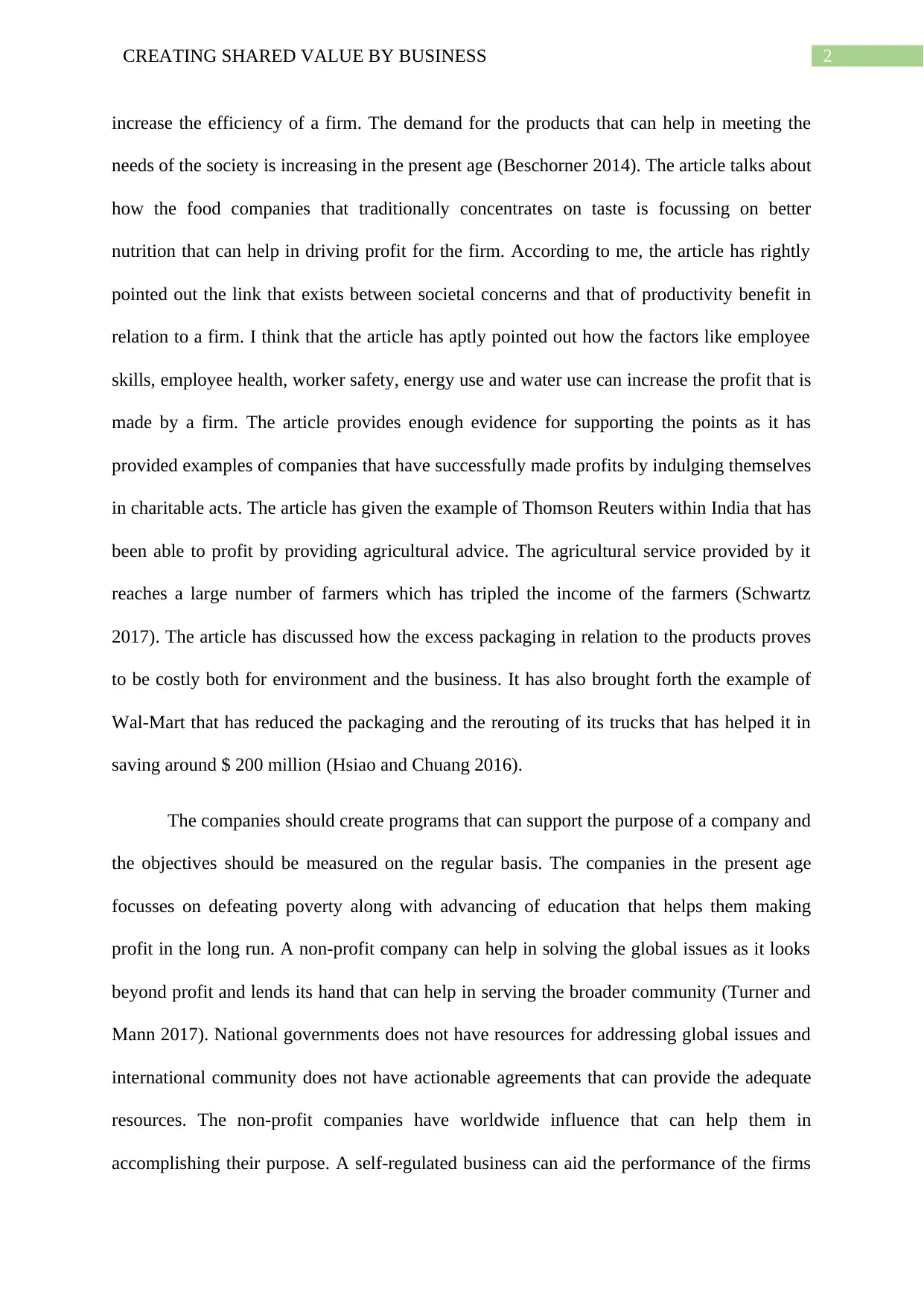
2CREATING SHARED VALUE BY BUSINESS
increase the efficiency of a firm. The demand for the products that can help in meeting the
needs of the society is increasing in the present age (Beschorner 2014). The article talks about
how the food companies that traditionally concentrates on taste is focussing on better
nutrition that can help in driving profit for the firm. According to me, the article has rightly
pointed out the link that exists between societal concerns and that of productivity benefit in
relation to a firm. I think that the article has aptly pointed out how the factors like employee
skills, employee health, worker safety, energy use and water use can increase the profit that is
made by a firm. The article provides enough evidence for supporting the points as it has
provided examples of companies that have successfully made profits by indulging themselves
in charitable acts. The article has given the example of Thomson Reuters within India that has
been able to profit by providing agricultural advice. The agricultural service provided by it
reaches a large number of farmers which has tripled the income of the farmers (Schwartz
2017). The article has discussed how the excess packaging in relation to the products proves
to be costly both for environment and the business. It has also brought forth the example of
Wal-Mart that has reduced the packaging and the rerouting of its trucks that has helped it in
saving around $ 200 million (Hsiao and Chuang 2016).
The companies should create programs that can support the purpose of a company and
the objectives should be measured on the regular basis. The companies in the present age
focusses on defeating poverty along with advancing of education that helps them making
profit in the long run. A non-profit company can help in solving the global issues as it looks
beyond profit and lends its hand that can help in serving the broader community (Turner and
Mann 2017). National governments does not have resources for addressing global issues and
international community does not have actionable agreements that can provide the adequate
resources. The non-profit companies have worldwide influence that can help them in
accomplishing their purpose. A self-regulated business can aid the performance of the firms
increase the efficiency of a firm. The demand for the products that can help in meeting the
needs of the society is increasing in the present age (Beschorner 2014). The article talks about
how the food companies that traditionally concentrates on taste is focussing on better
nutrition that can help in driving profit for the firm. According to me, the article has rightly
pointed out the link that exists between societal concerns and that of productivity benefit in
relation to a firm. I think that the article has aptly pointed out how the factors like employee
skills, employee health, worker safety, energy use and water use can increase the profit that is
made by a firm. The article provides enough evidence for supporting the points as it has
provided examples of companies that have successfully made profits by indulging themselves
in charitable acts. The article has given the example of Thomson Reuters within India that has
been able to profit by providing agricultural advice. The agricultural service provided by it
reaches a large number of farmers which has tripled the income of the farmers (Schwartz
2017). The article has discussed how the excess packaging in relation to the products proves
to be costly both for environment and the business. It has also brought forth the example of
Wal-Mart that has reduced the packaging and the rerouting of its trucks that has helped it in
saving around $ 200 million (Hsiao and Chuang 2016).
The companies should create programs that can support the purpose of a company and
the objectives should be measured on the regular basis. The companies in the present age
focusses on defeating poverty along with advancing of education that helps them making
profit in the long run. A non-profit company can help in solving the global issues as it looks
beyond profit and lends its hand that can help in serving the broader community (Turner and
Mann 2017). National governments does not have resources for addressing global issues and
international community does not have actionable agreements that can provide the adequate
resources. The non-profit companies have worldwide influence that can help them in
accomplishing their purpose. A self-regulated business can aid the performance of the firms
⊘ This is a preview!⊘
Do you want full access?
Subscribe today to unlock all pages.

Trusted by 1+ million students worldwide
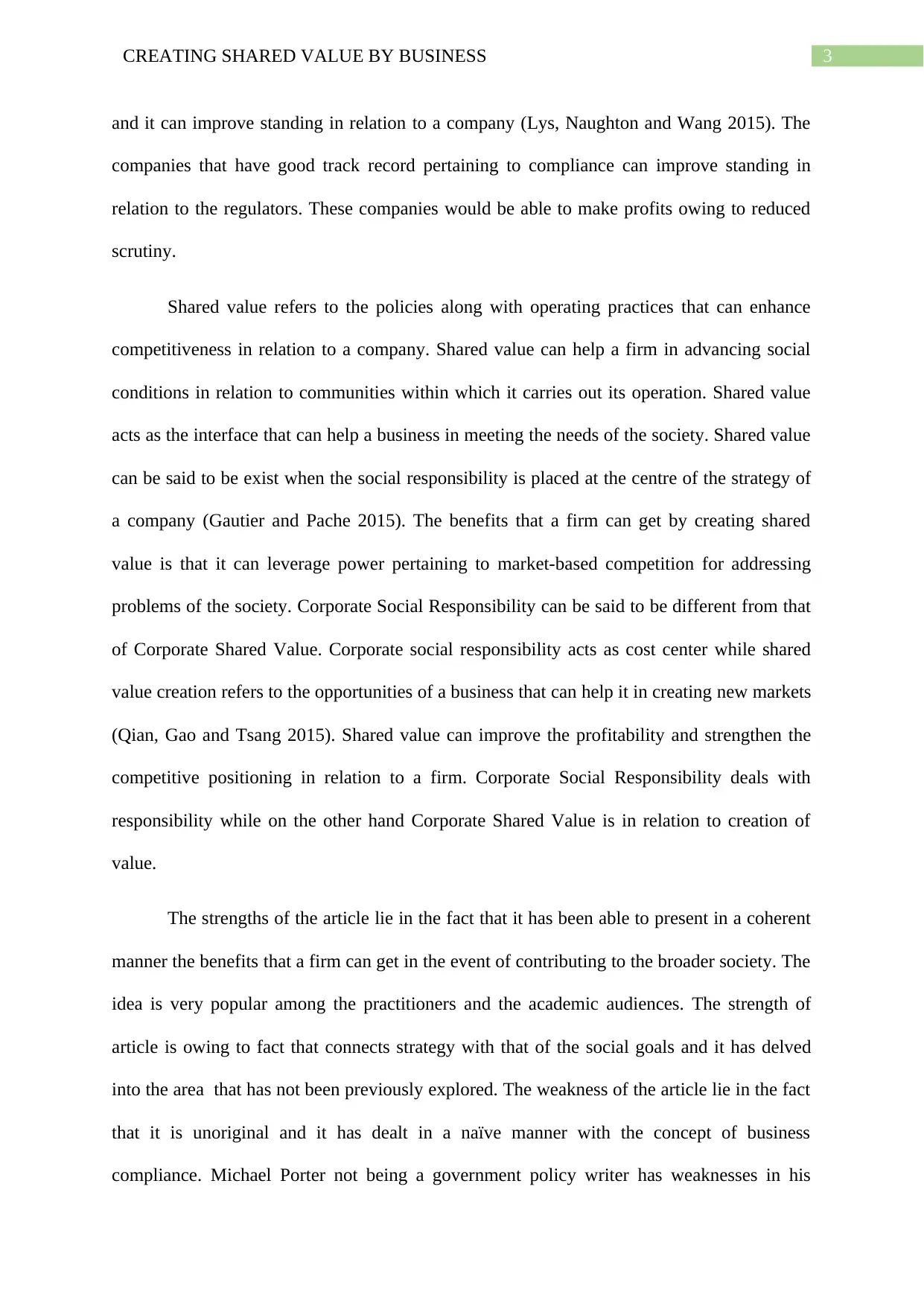
3CREATING SHARED VALUE BY BUSINESS
and it can improve standing in relation to a company (Lys, Naughton and Wang 2015). The
companies that have good track record pertaining to compliance can improve standing in
relation to the regulators. These companies would be able to make profits owing to reduced
scrutiny.
Shared value refers to the policies along with operating practices that can enhance
competitiveness in relation to a company. Shared value can help a firm in advancing social
conditions in relation to communities within which it carries out its operation. Shared value
acts as the interface that can help a business in meeting the needs of the society. Shared value
can be said to be exist when the social responsibility is placed at the centre of the strategy of
a company (Gautier and Pache 2015). The benefits that a firm can get by creating shared
value is that it can leverage power pertaining to market-based competition for addressing
problems of the society. Corporate Social Responsibility can be said to be different from that
of Corporate Shared Value. Corporate social responsibility acts as cost center while shared
value creation refers to the opportunities of a business that can help it in creating new markets
(Qian, Gao and Tsang 2015). Shared value can improve the profitability and strengthen the
competitive positioning in relation to a firm. Corporate Social Responsibility deals with
responsibility while on the other hand Corporate Shared Value is in relation to creation of
value.
The strengths of the article lie in the fact that it has been able to present in a coherent
manner the benefits that a firm can get in the event of contributing to the broader society. The
idea is very popular among the practitioners and the academic audiences. The strength of
article is owing to fact that connects strategy with that of the social goals and it has delved
into the area that has not been previously explored. The weakness of the article lie in the fact
that it is unoriginal and it has dealt in a naïve manner with the concept of business
compliance. Michael Porter not being a government policy writer has weaknesses in his
and it can improve standing in relation to a company (Lys, Naughton and Wang 2015). The
companies that have good track record pertaining to compliance can improve standing in
relation to the regulators. These companies would be able to make profits owing to reduced
scrutiny.
Shared value refers to the policies along with operating practices that can enhance
competitiveness in relation to a company. Shared value can help a firm in advancing social
conditions in relation to communities within which it carries out its operation. Shared value
acts as the interface that can help a business in meeting the needs of the society. Shared value
can be said to be exist when the social responsibility is placed at the centre of the strategy of
a company (Gautier and Pache 2015). The benefits that a firm can get by creating shared
value is that it can leverage power pertaining to market-based competition for addressing
problems of the society. Corporate Social Responsibility can be said to be different from that
of Corporate Shared Value. Corporate social responsibility acts as cost center while shared
value creation refers to the opportunities of a business that can help it in creating new markets
(Qian, Gao and Tsang 2015). Shared value can improve the profitability and strengthen the
competitive positioning in relation to a firm. Corporate Social Responsibility deals with
responsibility while on the other hand Corporate Shared Value is in relation to creation of
value.
The strengths of the article lie in the fact that it has been able to present in a coherent
manner the benefits that a firm can get in the event of contributing to the broader society. The
idea is very popular among the practitioners and the academic audiences. The strength of
article is owing to fact that connects strategy with that of the social goals and it has delved
into the area that has not been previously explored. The weakness of the article lie in the fact
that it is unoriginal and it has dealt in a naïve manner with the concept of business
compliance. Michael Porter not being a government policy writer has weaknesses in his
Paraphrase This Document
Need a fresh take? Get an instant paraphrase of this document with our AI Paraphraser
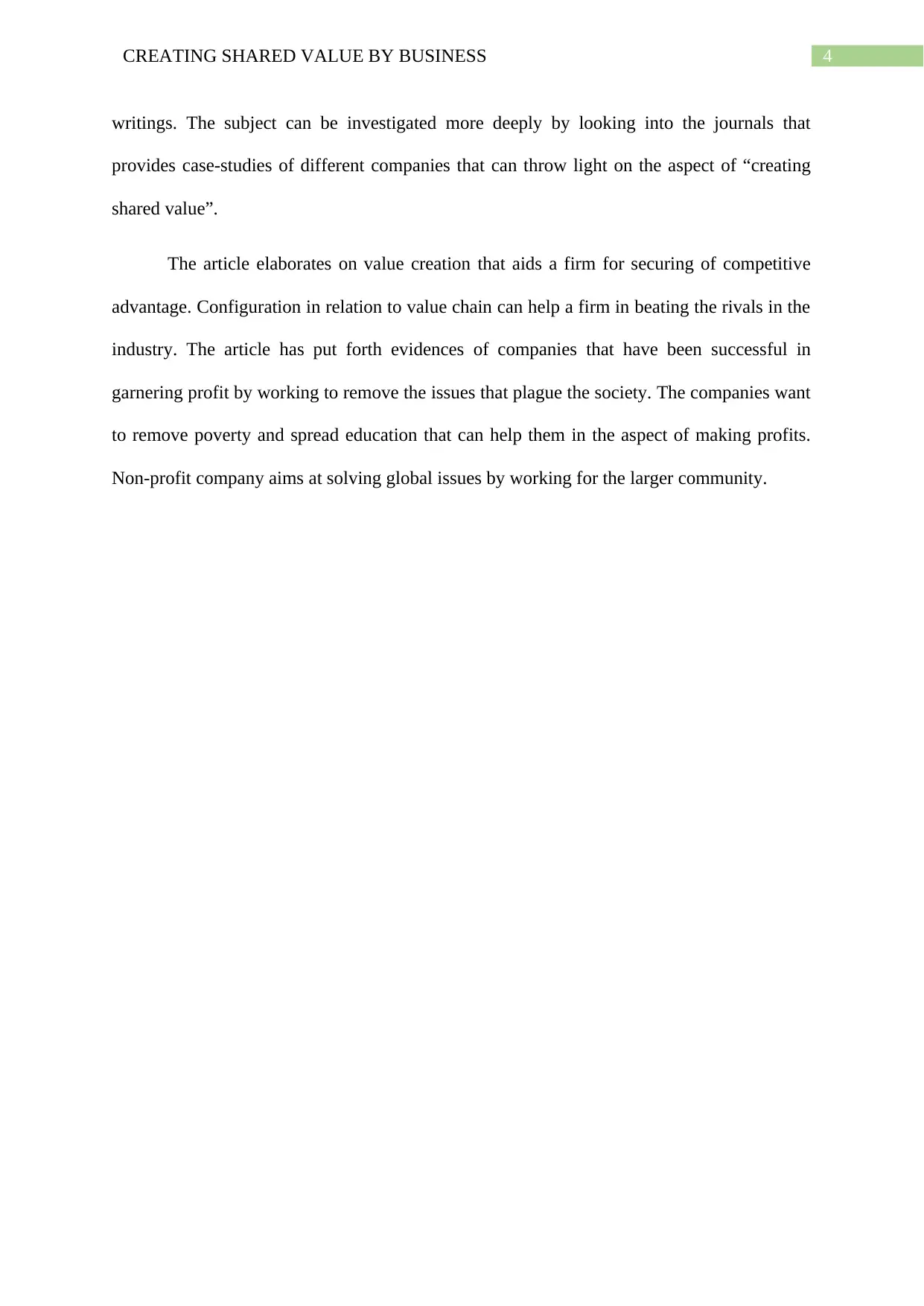
4CREATING SHARED VALUE BY BUSINESS
writings. The subject can be investigated more deeply by looking into the journals that
provides case-studies of different companies that can throw light on the aspect of “creating
shared value”.
The article elaborates on value creation that aids a firm for securing of competitive
advantage. Configuration in relation to value chain can help a firm in beating the rivals in the
industry. The article has put forth evidences of companies that have been successful in
garnering profit by working to remove the issues that plague the society. The companies want
to remove poverty and spread education that can help them in the aspect of making profits.
Non-profit company aims at solving global issues by working for the larger community.
writings. The subject can be investigated more deeply by looking into the journals that
provides case-studies of different companies that can throw light on the aspect of “creating
shared value”.
The article elaborates on value creation that aids a firm for securing of competitive
advantage. Configuration in relation to value chain can help a firm in beating the rivals in the
industry. The article has put forth evidences of companies that have been successful in
garnering profit by working to remove the issues that plague the society. The companies want
to remove poverty and spread education that can help them in the aspect of making profits.
Non-profit company aims at solving global issues by working for the larger community.
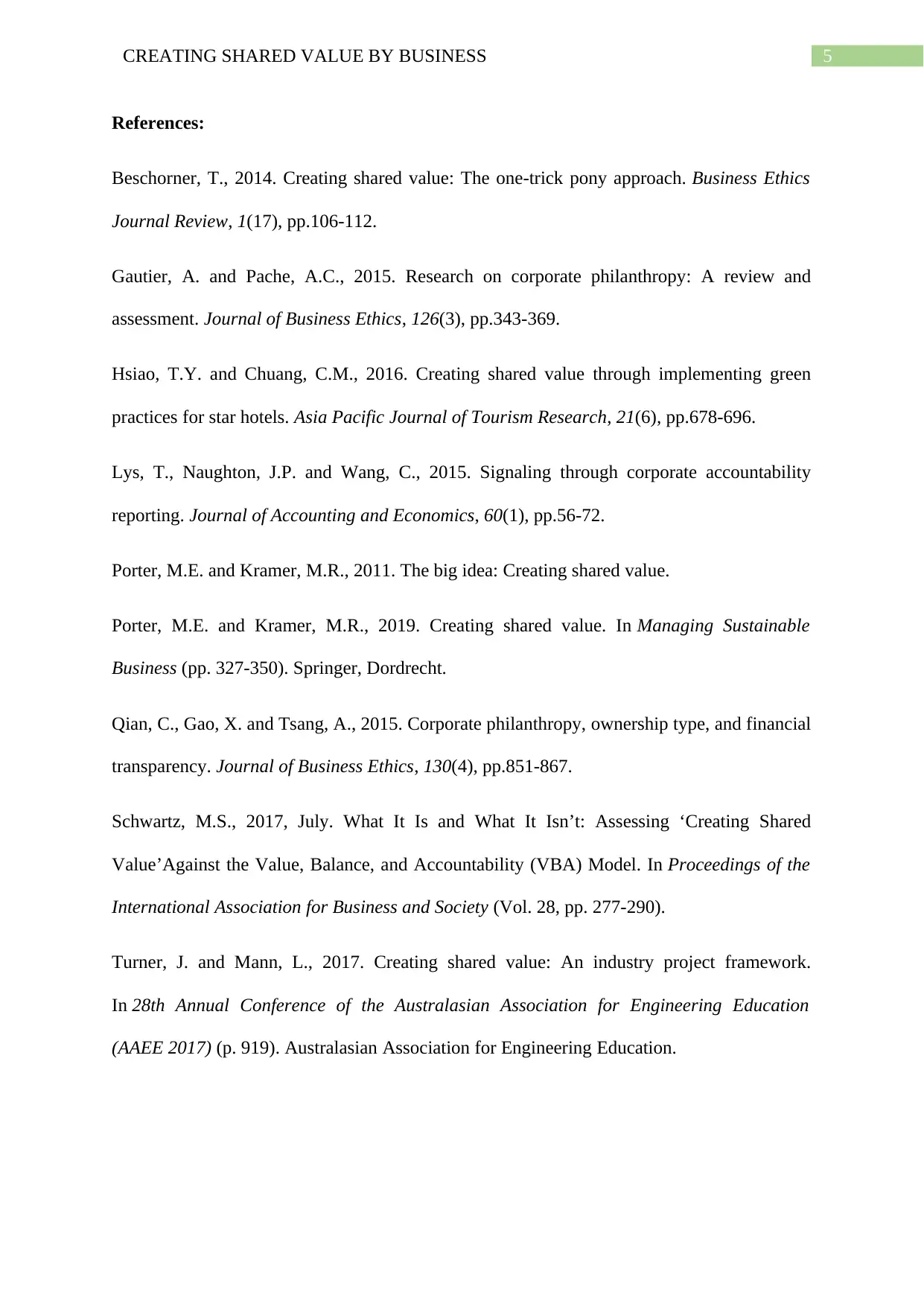
5CREATING SHARED VALUE BY BUSINESS
References:
Beschorner, T., 2014. Creating shared value: The one-trick pony approach. Business Ethics
Journal Review, 1(17), pp.106-112.
Gautier, A. and Pache, A.C., 2015. Research on corporate philanthropy: A review and
assessment. Journal of Business Ethics, 126(3), pp.343-369.
Hsiao, T.Y. and Chuang, C.M., 2016. Creating shared value through implementing green
practices for star hotels. Asia Pacific Journal of Tourism Research, 21(6), pp.678-696.
Lys, T., Naughton, J.P. and Wang, C., 2015. Signaling through corporate accountability
reporting. Journal of Accounting and Economics, 60(1), pp.56-72.
Porter, M.E. and Kramer, M.R., 2011. The big idea: Creating shared value.
Porter, M.E. and Kramer, M.R., 2019. Creating shared value. In Managing Sustainable
Business (pp. 327-350). Springer, Dordrecht.
Qian, C., Gao, X. and Tsang, A., 2015. Corporate philanthropy, ownership type, and financial
transparency. Journal of Business Ethics, 130(4), pp.851-867.
Schwartz, M.S., 2017, July. What It Is and What It Isn’t: Assessing ‘Creating Shared
Value’Against the Value, Balance, and Accountability (VBA) Model. In Proceedings of the
International Association for Business and Society (Vol. 28, pp. 277-290).
Turner, J. and Mann, L., 2017. Creating shared value: An industry project framework.
In 28th Annual Conference of the Australasian Association for Engineering Education
(AAEE 2017) (p. 919). Australasian Association for Engineering Education.
References:
Beschorner, T., 2014. Creating shared value: The one-trick pony approach. Business Ethics
Journal Review, 1(17), pp.106-112.
Gautier, A. and Pache, A.C., 2015. Research on corporate philanthropy: A review and
assessment. Journal of Business Ethics, 126(3), pp.343-369.
Hsiao, T.Y. and Chuang, C.M., 2016. Creating shared value through implementing green
practices for star hotels. Asia Pacific Journal of Tourism Research, 21(6), pp.678-696.
Lys, T., Naughton, J.P. and Wang, C., 2015. Signaling through corporate accountability
reporting. Journal of Accounting and Economics, 60(1), pp.56-72.
Porter, M.E. and Kramer, M.R., 2011. The big idea: Creating shared value.
Porter, M.E. and Kramer, M.R., 2019. Creating shared value. In Managing Sustainable
Business (pp. 327-350). Springer, Dordrecht.
Qian, C., Gao, X. and Tsang, A., 2015. Corporate philanthropy, ownership type, and financial
transparency. Journal of Business Ethics, 130(4), pp.851-867.
Schwartz, M.S., 2017, July. What It Is and What It Isn’t: Assessing ‘Creating Shared
Value’Against the Value, Balance, and Accountability (VBA) Model. In Proceedings of the
International Association for Business and Society (Vol. 28, pp. 277-290).
Turner, J. and Mann, L., 2017. Creating shared value: An industry project framework.
In 28th Annual Conference of the Australasian Association for Engineering Education
(AAEE 2017) (p. 919). Australasian Association for Engineering Education.
⊘ This is a preview!⊘
Do you want full access?
Subscribe today to unlock all pages.

Trusted by 1+ million students worldwide
1 out of 6
Related Documents
Your All-in-One AI-Powered Toolkit for Academic Success.
+13062052269
info@desklib.com
Available 24*7 on WhatsApp / Email
![[object Object]](/_next/static/media/star-bottom.7253800d.svg)
Unlock your academic potential
Copyright © 2020–2025 A2Z Services. All Rights Reserved. Developed and managed by ZUCOL.





